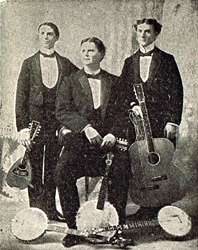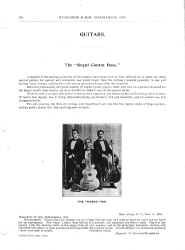|

Regal
Harp Guitars
by Gregg Miner
July, 2012
Updated April 2021
Dear
reader, Are you, like me,
completely lost regarding the "Regal" brand name
and/or company/companies? Well, you are not alone!
Unfortunately, this page is dedicated only to the harp guitars,
but there is hope! In early 2012, energetic researcher Bob Carlin
published his brand new book, Regal Musical Instruments:
1895-1955, and you can see the Timeline there, and many
other new details of the company, and hopefully begin to wrap your
head around the puzzle! |
 |
 |
 |
 |
| Emil Wulschner &
Son building, shown in
The Music Trade Review, Sept 10, 1898.
|
The Regal Manufacturing
Company in The Music Trade Review, April 6, 1901. At the
same time (as of April, 1900), the separate "Wulschner
& Son" had become "Wulschner Music
Company." The story behind all this is
complicated...best buy the book! |
Postcard showing the
Wulschner-Stewart company building sometime in or after late
1903. |
I think I've already said about all I know about this
subject in my blog
of January 26, 2011, but I thought it would be good to also archive
in one place all the specimens - surviving or historical - that come to
light. Besides the inherent historical and entertainment value,
perhaps these images will help the ongoing discussion on which - if any
- of the early 1900's Regal harp guitars may have been built by the
Larson brothers. My understanding is that this has been - and
continues to be - a volatile topic.
A quick note about the design of the original Regal harp
guitar. With those ridiculously short sub-bass strings - meant to be
tuned to standard harp guitar pitch (descending from D below the neck's E
string, diatonically to F) - attached to the decorative slab of wood
inserted into the crook of the upper bass bout, this is an immediately
recognizable harp guitar. And there's nothing else like it,
right? Well, that's what we've all long thought. Then a couple
of years ago, an image or two (and finally, three) have cropped up that show
a Harwood harp guitar with a very
similar design, introduced before 1895. This was almost certainly the
inspiration (source) of the curious Regal. More importantly, I believe
that Harwood was America's very first production harp guitar.
 |
It would seem odd that the new Regal factory - shown here in
1901 (from TMTR), with a Regal harp guitar prominently displayed -
was incapable of building their own instrument...unless the instrument capture in
the woodcut is a "ringer"? - a Larson-built instrument
brought in to spice up the scene?!
Or were the possible Larson-built instruments only prior
to this period? Irregardless, it is especially
strange that no Regal harp guitars with labels pointing to the
1901-1904 period have ever surfaced.
In the current thinking of Bob Hartman, the builders of the first two pre- or early-1900 instruments below
are "believed to be Robert Maurer or the Larsons," while the
same-era "sunburst"
specimen is up for grabs. Curiously, while the first two
were built under the tension, the "sunburst" was
not. The third
"lost Marc Silber" instrument (my term) clearly has a
label, but no one seems to know what it is.
Bob further ties the 10th fret - as opposed to 9th fret -
marker to a possible Larson-built provenance (first two specimens
compared to second two). |
| I have again scoured the web, my files, and those of
Bob Hartman, and it seems we have located today just four
surviving specimens.
Note that, despite seemingly identical bodies,
wood and trim, each has completely different inlays on the
headstock and fingerboard. Also interesting is the
non-standard inlay position of the 9th/10th fret. Yet,
interestingly, despite the harp guitar in the above factory image
from April, 1901, 3 of the 4 (and possibly even the 4th) surviving
specimens have the exact same Regal paper label and "Wulschner
& Son leather medallion (at right), indicating that they would
have been (theoretically) built before April, 1900, when the firm
re-incorporated as the "Wulschner Music Company." How much earlier? So far, the oldest
provenance depicting one of these harp guitars is an image in
the May/June,
1899 issue of Cadenza (courtesy of the new Regal book). |

|
 |
 |
 |
 |

|

|
 |
|
The best documented
specimen, long posted on Frank Ford's frets.com site.
We believe it is the same instrument seen in this early 1980s photo of
Mark Cummings from Bob Hartman's files. Gryphon Instruments sold it some 30
years ago to a still-proud (anonymous) owner. Note that it
differs from the other three in having zither pin sub-bass
tuners, rather than Gibson-style friction tuners.
Label
|
This specimen has long
hung on the wall at Intermountain Guitar & Banjo, part of
the owners' collection.
Label
(photos
courtesy of Leo Coulson) |
This specimen,
sold in auction in November, 2013.
It appears to have simple binding, rather than
the multi-colored herringbone or marquetry of most of the
others. |
This is the most recent specimen, which I
acquired in late 2016 from a private party. Like all of them, it
had no provenance. Its label is absent and it has the thick
leather "stamp," fairly unreadable. Like all the
others, the head and neck inlays give it its own unique
"fingerprint." |
The infamous
"sunburst" Regal, at left from the book of the Chinery
Collection, and at right, in its current state (June, 2012) for
sale at Intermountain Guitar & Banjo. Though the Chinery/Bacon
book amusingly gives "c.1930" as a date, this was
probably built in the same short period as the others. The non-period finish was done
some time ago by persons unknown (personal testimony). The color correction (and clean-up?) of the book photo
is curious.
Label |
The source of this
photo currently eludes me. It comes from Andy Wahlberg's
site who long ago scanned it from some guitar book. Can anyone
locate this? Click to see additional images taken long
ago by Marc Silber, submitted by Bob Hartman. We are pretty certain
this is one and the same instrument. The label (which sure
looks like the double rectangle and oval Wulschner & Son set
like those at left), and its whereabouts,
are unknown. |
|
Note that the four instruments on the left have the marker at the 10th
fret, while the two at right have the marker at the 9th fret.
|
|
|
Next are some enhanced images of specimens
from some of the clearer historical photos
(see further below for the full images).
|
|
At right is the
personal instrument of well-known recording artist Roy
Butin.
It has the neck inlay of specimen #2 (Intermountain) above (though
may have no 3rd fret inlay), but appears to have the
headstock inlay of specimen #4 - indicating a new (8th) specimen.
Note the two labels visible.
It actually could be a duplicate of the following
instrument(s) below: |

|

|

|
 |
Left image is from the Pomeroy group, at right the
specimen from the two Kuhn sheet music copies.
To my eye, the inlays of both specimens could be
exactly the same.
The fact that Pomeroy's guitarist's instrument was
photographed (and played) in 1900, and the Kuhn's in
1912 & 1913 allows for the possibility that
they procured the very Pomeroy instrument twelve years
later...
Note that it has some specific stain or wear above
the bridge, and that in the left (earlier, 1912) image,
there is some strange additional bridge insert or
something. |
 |
|
|
 |
This Regal appears to match specimen #2 (Intermountain).
From the May/June,
1899 issue of Cadenza. |
This is a 7th specimen (its inlays are different from all
others) from the September, 1909 Cadenza magazine. |
 |
|
Before leaving "Specimens," we of
course need to acknowledge the fact that the Regal brand name
survived...here are later instruments from the 1920's and '30s.
 |
 |
 |
 |
| This image is
from the c.1930 Tonk Brothers catalog and shows a
completely different harp guitar from the later Regal
Company. |
Two
(?) specimens are known. At left, as purchased by
Tony Marcus around 2005, at right, listed in 2015 at
Schoenburg Guitars. |
Stutzman's
Guitar Center owns this later Regal harp mandolin. |
|
|
And finally, all historical photos I have
managed to acquire or access: |
|


























